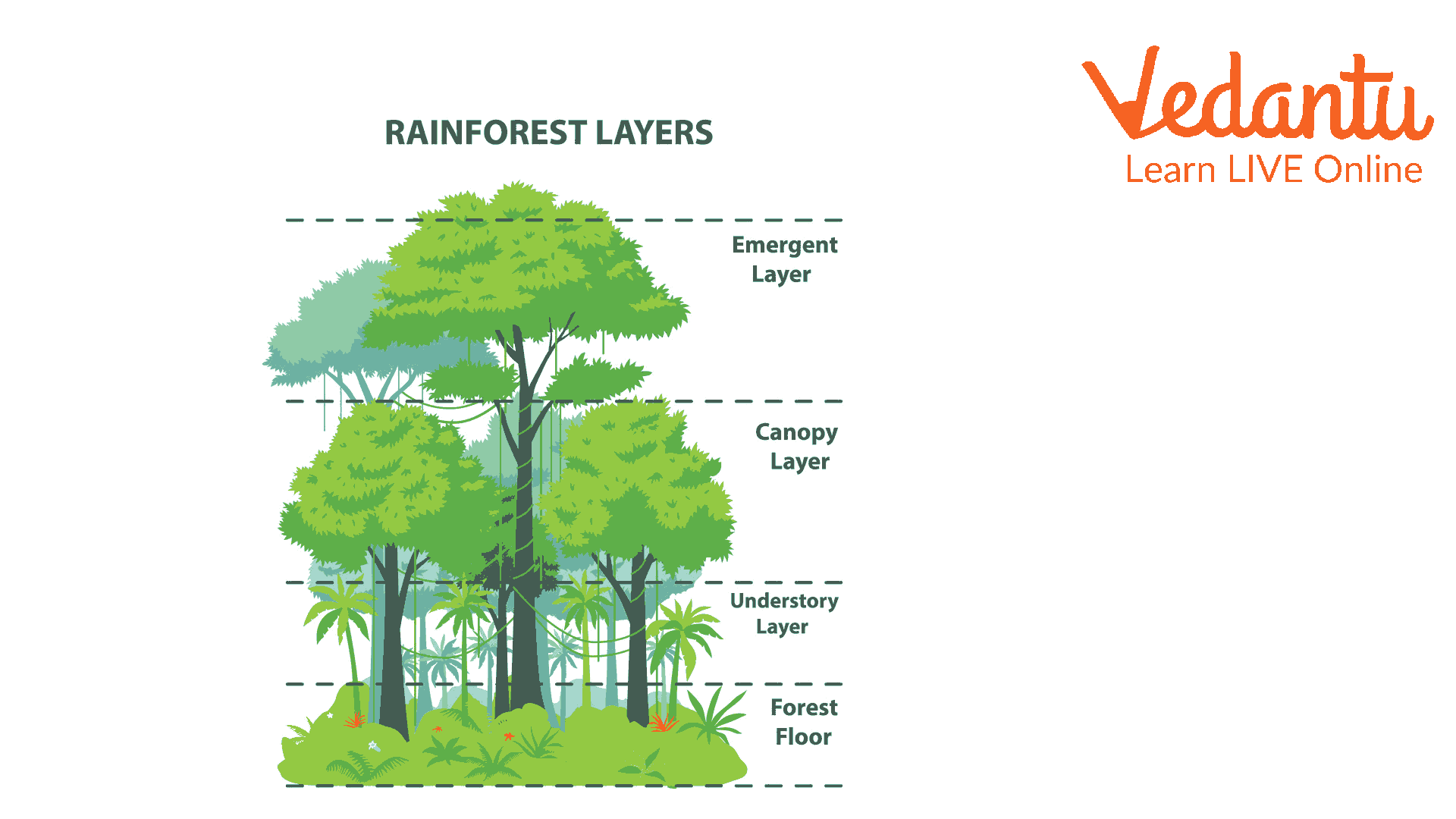




An Overview of Rainforest
As the name suggests, rainforests are woodlands that experience annual rainfall totals that are significantly higher than the average of 68 to 78 inches. According to Rainforest geography, most of the world's rainforests are found in regions close to the equator in the middle of the planet, including South and Central America, Africa, Asia, and Australia.
A rainforest is a heavily forested area that receives a significant quantity of precipitation yearly — 80 inches, to be exact. Since a warm environment is necessary for a rainforest to exist, it makes sense that most tropical rainforest regions are found on or around the equator.
Different Layers of Rainforest

The Different Layers of the Rainforest
The following are four layers of the rainforest. Each layer contains unique flora and fauna that have evolved to live in a specific environment.
Emergent Layer - The emergent layer consists of the tallest trees, some of which reach 200 feet. Butterflies, bats, and giant birds of prey live natively in this layer. The most sunlight is available to trees at the emergent layer, but they also have to contend with severe winds, extremely high temperatures, and little humidity. The principal fauna include eagles, bats, monkeys, and butterflies.
Canopy Layer - The tops of most trees make up the canopy layer, the thickest layer in the rainforest. The trees have smooth, oval leaves that interlock, creating a vast maze with a broad roof over the other two tiers. Most birds and creatures that can navigate to the emergent layer in search of solid light reside in the canopy layer. Typically, various plant species wrap and connect the branches of trees in the canopy layer.
Understory Layer - It makes up the rainforest's middle layer between the canopy and the ground. Snakes, giant cats, and lizards live there. The rainforest is very dark. This stratum is open and teems with young trees and green herbaceous plants that can make do with little light. The most well-known indoor plants come from this tier.
Forest Floor - The final layer of a rainforest is the forest floor. This layer receives far less sunlight than 2%. Consuming dead animals and plant matter is a common means of survival for many creatures living in the forest layer.
Different Types of Rainforest
Tropical Rainforest - The typical monthly temperature in tropical rainforests is above 18°C throughout the year, with an average of roughly 400 inches of precipitation per year. These are situated between the Tropics of Cancer and Capricorn in the monsoon trough as per the geographic location of the tropical rainforest. Equatorial climates, sometimes called tropical rainforest climates, are ideal for these kinds of woods.
Temperate Rainforest - The typical annual rainfall in temperate rainforests ranges from 50 to 140 inches, while the average daily mean temperature is between 50 and 80 degrees.
These can be found in arid regions. Evergreen trees that are 500–1000 years old can be found there. The seasonal climate of the temperate rainforests results in a lower diversity of flora and fauna. The leaves on trees are shaped like needles. North America, East Asia, Europe, South America, Australia, and New Zealand are frequently home to temperate rainforests.
Amazing Rainforest Facts for Kids
Rainforests cover approximately 6% of the area on Earth.
Rival strawberry poison dart frogs may struggle for up to 20 minutes in the rainforests of Central America!
A raindrop can travel from the dense canopy of rainforest to the ground in ten minutes.
The Daintree rainforest in Australia is home to a tree known as the idiot fruit.
At least 250 cm of rain falls on rainforests each year. Sometimes, it's 450cm, which is almost twice as much.
The Amazon rainforest in South America is so large that it would rank ninth in the world if it were a nation.
Black howler monkeys live in Latin American forests, and we can hear their sounds from approximately 5 kilometres away!
Modern pharmaceuticals contain 25% components from rainforest plants.
Around 80% of the flowers in the Australian rainforests are unique to that region.
On the Caribbean island of Dominica, a lake inside a jungle sizzles at about 88°C.
Conclusion
Rainforests convert carbon dioxide from human-made activities into oxygen, which is necessary for the survival of all animals and people. Millions of different varieties of exotic plants and animals can also be found there. The rainforest provides many necessities for humans and other living things to survive.
FAQs on Interesting Facts About Rainforests for Kids
1. What type of rainforest is known as the "Earth's lungs"?
Tropical rainforests have a highly rapid rate of decomposition. Due to their role in providing oxygen to the atmosphere, they are frequently referred to as "Earth's lungs."
2. Why is the ground of the rainforest always dark?
The ground in a rainforest is very dark. There are many dead plants and leaves since the canopy above prevents sunlight from reaching the ground. In reality, only 2% of the Sun hits the Earth.
3. How are rainforests getting destroyed?
There are tropical rainforests in many developing nations. Some developing countries sell timber and other rainforest resources to raise funds. This frequently destroys vast tracts of forest. To use the area for farming and cattle grazing, rainforests are also cleared or burned.









